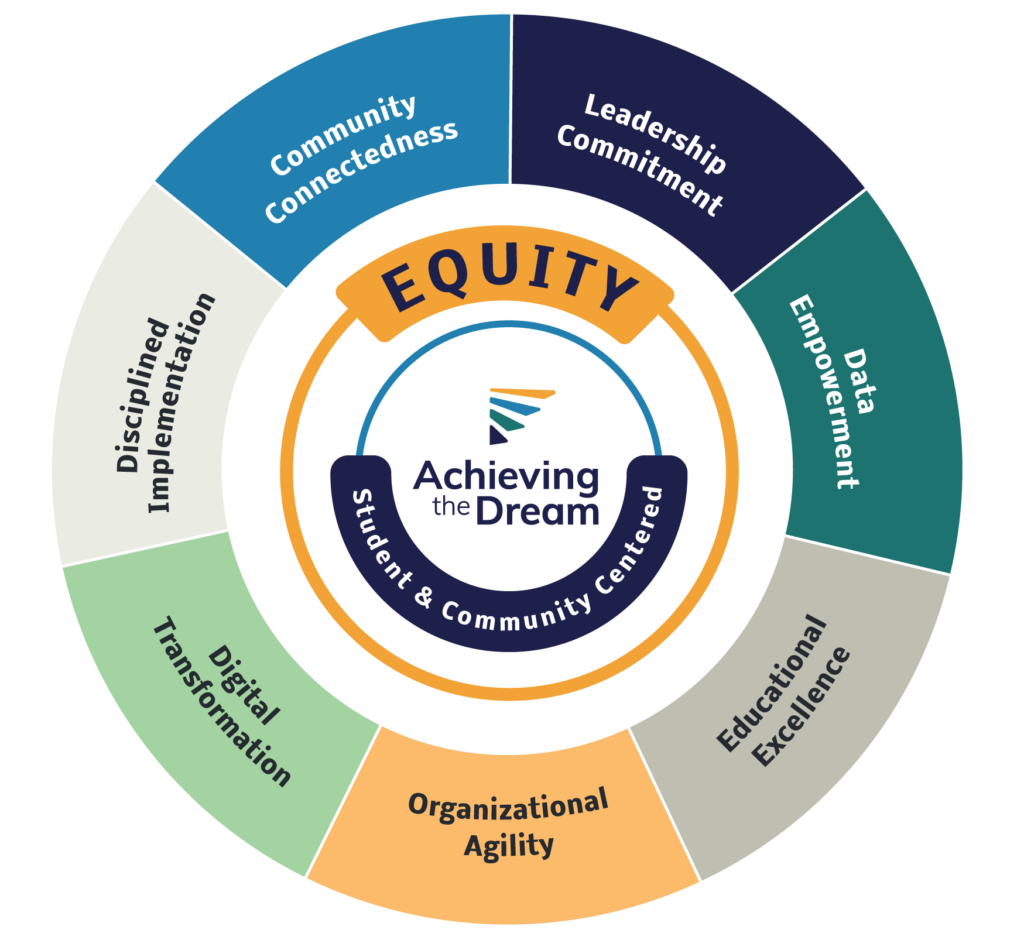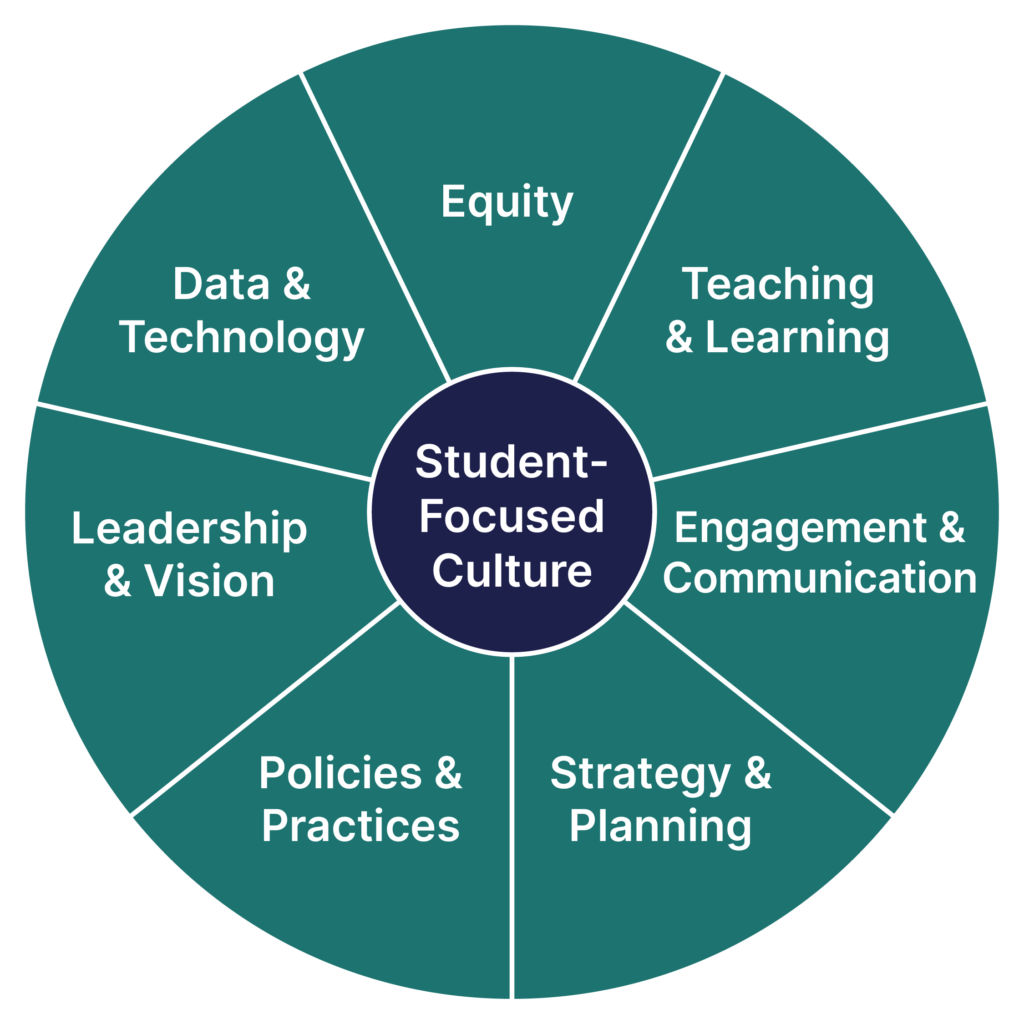ATD’s enduring commitment to taking a data-informed approach to our colleges’ student success efforts means that our Network is continually learning and growing, and our work with colleges is constantly evolving to reflect the changing needs, priorities, and strengths of their students and communities.
That’s why we are excited to reveal an updated version of the Institutional Capacity Framework — and the accompanying Institutional Capacity Assessment Tool (ICAT) — which outlines the foundational capacities we believe ATD Network colleges must develop to ensure their readiness and capacity for driving equitable student success outcomes.
The updated ATD Institutional Capacity Framework

The updated ICAT embeds elements of the current capacity framework but in more dynamic and interconnected ways. We are excited to highlight a few key changes that reflect the growth, momentum, and impact of the ATD Network and our aspirations for the future.
More details will follow in the fall of this year as the updated ICAT is rolled out to the whole ATD Network.
Equity at the center
“Equity,” one of the current seven fundamental capacities that also runs through the other six, is now at the center of the wheel and is explicitly connected to all the capacities.
“Student success work is equity work, and it cannot be done in isolation or bolted on as an afterthought — something ATD has known from the beginning and has stated in our organizational equity statement,” noted Dr. Karen A. Stout, president and CEO of Achieving the Dream. “It must be connected deeply and dynamically within the broader systems of colleges and our communities, and it begins with a deep understanding of our students and their lived experiences. The updated ICAT wheel visually captures the dual nature of how we must think about equity — both as a capacity in and of itself and as a student-centered mindset that must be infused into every other facet of our work.”
Students and community at the center
More significantly, “Community” also sits at the center of the updated Institutional Capacity Framework wheel. Previously, all capacities were designed to support a student-centered culture; now, colleges are working to focus on student-centeredness and community vitality simultaneously.
Our 2021 strategic vision reinforced our belief that America’s community colleges are not just institutions of higher education but also “profoundly accessible hubs of learning, credentialing, and economic mobility” in their communities.
To achieve this vision, colleges must work with the community in mind — whether that means designing curricula that respond to the community’s cultural context or forming strategic partnerships with external organizations that serve the community’s needs.
“The most relevant community colleges take the form of their communities while also shaping the future form of the communities they serve,” Dr. Stout wrote in her introduction to ATD’s 2021 vision statement.
By placing a focus on students and community at the center of our whole-college transformation work, we are following the ATD Network’s lead and moving from a linear model that assumes student success will produce community vitality to a cyclical approach that encourages institutions to develop lifelong learners who build strong communities while it also supports community partnerships that will bolster student success.
New capacities: Organizational agility and community connectedness
New to the ICAT wheel is the “Organizational Agility” capacity, which acknowledges the complex environments within which community colleges operate. Inclusion of this capacity emphasizes not just the fluid communication that the previous ICAT iteration called for in its “Engagement and Communication” capacity, but it also encompasses a much broader value of institutional nimbleness.
While the rapid and broad-sweeping change required of colleges during the COVID pandemic is, perhaps, the most palpable example of a situation requiring institutional dexterity, the need for changes of much smaller proportions emerge routinely for colleges and communities — whether those be changes in the funding model for a state’s community colleges or the closing of a local business that requires large-scale reskilling of workers in the area — and institutions must meet these needs with a sophisticated level of adaptability and resilience.
Also new, the “Community Connectedness” capacity recognizes the explicit value and importance of strategic partnerships for colleges to leverage their localness and harness their potential to be collective impact hubs to drive transformation in their communities.
Additional updates
The former “Data and Technology” capacity is now two capacities: “Data Empowerment” and “Digital Transformation.” Data Empowerment recognizes the importance of building a new data mindset around data access and literacy and having defined student success metrics used to track continuous improvement. Digital Transformation emphasizes the need to think more deeply about our technology systems as being transformational, given the promise of digital and personalized courseware, the potential of AI, and the known and unknown questions facing us around digital ethics.
Building a culture of teaching and learning excellence remains at the core of the former “Teaching and Learning,” now the “Educational Excellence” capacity, which expands our thinking to be explicit about the importance of holistic student supports and program health and relevancy.
The “Leadership” capacity now includes a deeper and more intentional connection to the role of colleges’ boards and a more explicit call for a clear and well-understood vision and alignment of leaders, including middle leaders, around a common purpose.
The former “Strategic Planning” and “Policy and Practice” capacities are now embedded in the “Educational Excellence” and “Leadership” capacities, while a new capacity, “Disciplined Implementation,” anchors the ICAT updates. This is an area where we see our colleges falling short and, in many ways, is a “back to the future” revelation given that “systemic institutional improvement” was one of the founding five principles of ATD.
Innovation and evolution
The new version of the Institutional Capacity Framework follows the ATD tradition of evidence-based progress and innovation. The first version of the framework was based on the five guiding principles upon which ATD was founded:
- Committed leadership
- Use of evidence to improve programs and services
- Broad engagement
- Systemic institutional improvement
- Equity
Following extensive testing and refining with 10 pilot colleges in 2015, these five founding principles turned into seven essential capacities that support a student-focused culture.
The first Institutional Capacity Framework:
At the time, the framework reflected a growing understanding throughout the Network that discrete, targeted interventions were not taking colleges’ efforts far enough; they needed to cultivate student-focused cultures that supported equitable student success throughout the institution.
“We can no longer reform along the margins,” Dr. Stout said in an address at Anne Arundel Community College in 2015, referring to the whole-college approach ATD Network colleges were beginning to take as they tackled challenges in access, success, and equity.
It is a philosophy that Dr. Stout emphasized at DREAM 2016, where she unveiled the first set of major changes to the Institutional Capacity Framework. “It’s not the adoption of one intervention that will propel your advancement,” she stated. “Rather, it is the adoption of a change management strategy that blends structural, process, and attitudinal changes built around the … capacities of the ICAT that will anchor your ability to advance big interventions … To sustain change, colleges must first attend to their fundamentals before they can hit the three-run home run.”
For the last eight years, the Institutional Capacity Framework has helped college leaders, educators, and practitioners identify tangible areas of work that affect student success — and actionable steps to build capacity. ATD’s data team has continued to listen to college feedback and to analyze information about the field at large, committed to maintaining a resource that serves colleges today.
“ICAT 2.0” represents the biggest update since the framework was first established, but it will not be the last. We will continue evolving with the field as leaders and as listeners. In our 20-year history, the strength of our work has always come from the collective learning of the ATD Network. That learning will continue to drive our vision and our efforts for the next 20 years and beyond.

